INTRODUCTION

Baby boomers are aging and increasingly make up a portion of those 65 and over. The older boomers are segmented between the birth years of 1946-1954. The younger boomers are segmented between 1955-1964.
Whereas the older boomers grew up in the optimism of the 1950s and early 1960s, the younger ones grew up with the pessimism of the late 1960s and 1970s. The rapid change over this time means that boomers have different characteristics based on when they were born. The oldest are now turning 70.
Members of the silent generation (the generation before) birth years range between 1925 and 1945, and were all shaped by the problems of that era including the Great Depression, and World War II. The younger members of the silent generation blend in more with the older baby boomers. The baby boomers are the largest consumer demographic, with 76.4 million spent in the United States. The size of the silent generation is about 50 million. Even though both generations are classified together as “senior citizens,” much differentiates them. These generations have the most spending power at the moment, so understanding them should be a priority for marketers.
This demographic is important because of their wealth and spending power; baby boomers control 70 percent of U.S. disposable income. Seniors in this generation don’t happen to be as brand loyal as some suspect. If they feel a brand doesn’t meet their needs, they are willing to switch. Learning to successfully market to this group of wealthy retirees is a must for any company or brand, and this white paper will explain the way to succeed.
SENIORS BY THE NUMBERS
These numbers and insights paint a picture of how important seniors are, and where they can be reached.
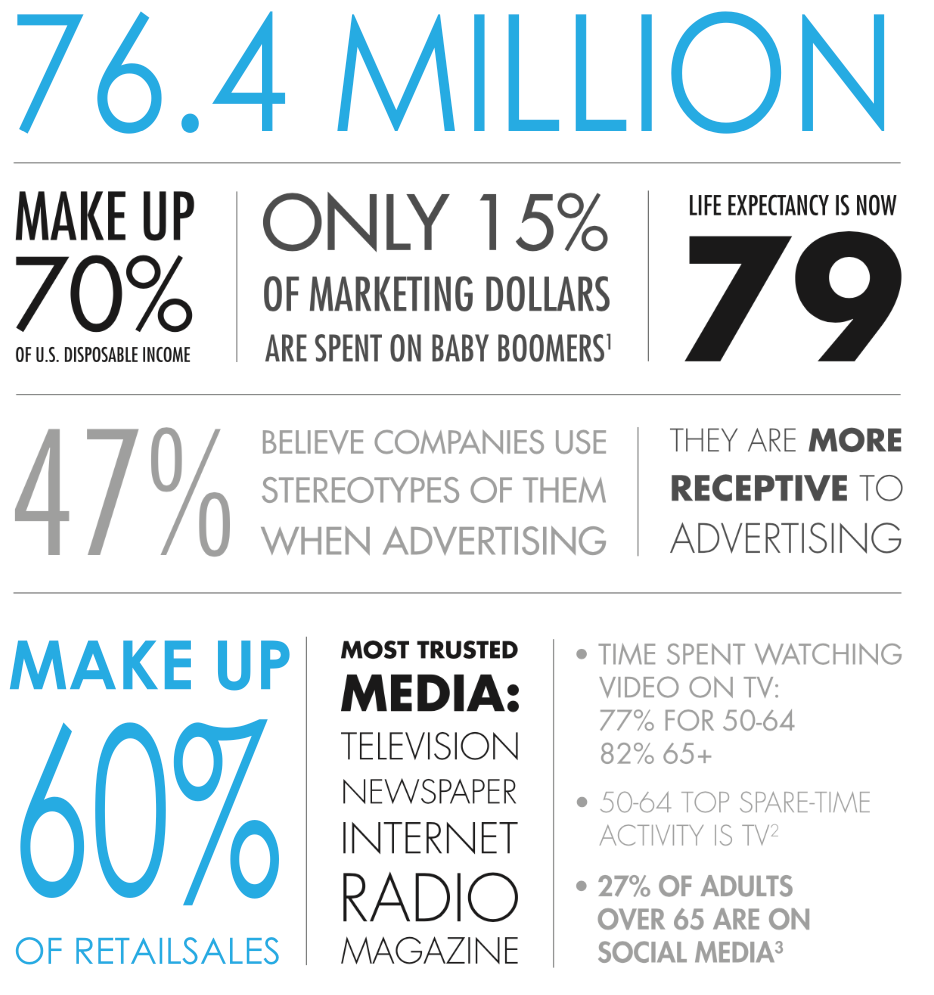

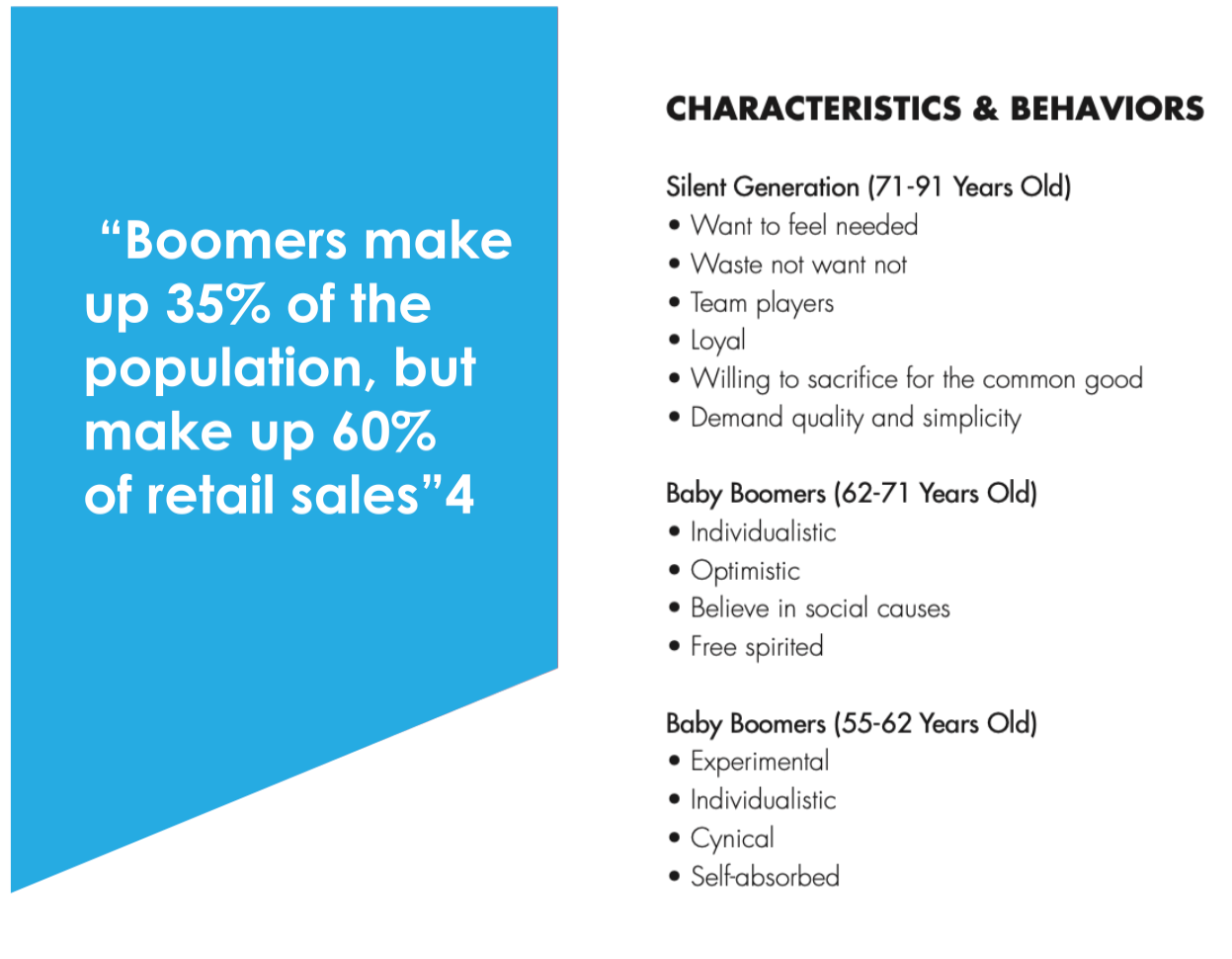
STEPS TO SUCCESSFUL SALES
Help Them Trust You
Seniors tend to be more discerning than younger consumers, frequently asking if they need the product. Building trust is important for such cautious consumers. They tend to do more research before making a purchase. A product with a stamp of approval from a reputable source, or a partnership with a trusted brand, establishes trust.
Make Your Message Understandable
‘Seniors want to be able to understand what they are getting themselves into. The harder something is to read, to understand or to access when needed, the more it will emphasize the loss of independence seniors often incur as they age. A suggestion is to use clear black writing over a white background.”
Give Them the Service They Want
“Seniors value service more than other generations, and they are willing to pay more. Many still remember when service was part of the shopping experience. They appreciate companies that make a point of looking after their customers. Free delivery or home visits have value in and of themselves.”
Recognize Their Independence
Seniors want to feel like they are still young and have all the benefits of youth, including independence. Try not to patronize them or sound condescending. For the most part, they are still willing to learn new things. Baby boomers are especially proud of their independence-as they are individualistic by nature-and are deciding to stay in their homes and at their jobs longer than previous generations.
Let Them Feel Safe With You
Seniors are more concerned than the average consumer about security, independence, lifestyle and family relationships.”* They are more risk averse. Marketing a product as making seniors feel safe-as well as living a good lifestyle is important for seniors.
Seniors tend to be more discerning than younger consumers, frequently asking if they need the product. Building trust is important for such cautious consumers. They tend to do more research before making a purchase. A product with a stamp of approval from a reputable source, or a partnership with a trusted brand, establishes trust.
Make Your Message Understandable
‘Seniors want to be able to understand what they are getting themselves into. The harder something is to read, to understand or to access when needed, the more it will emphasize the loss of independence seniors often incur as they age. A suggestion is to use clear black writing over a white background.”
Give Them the Service They Want
“Seniors value service more than other generations, and they are willing to pay more. Many still remember when service was part of the shopping experience. They appreciate companies that make a point of looking after their customers. Free delivery or home visits have value in and of themselves.”
Recognize Their Independence
Seniors want to feel like they are still young and have all the benefits of youth, including independence. Try not to patronize them or sound condescending. For the most part, they are still willing to learn new things. Baby boomers are especially proud of their independence-as they are individualistic by nature-and are deciding to stay in their homes and at their jobs longer than previous generations.
Let Them Feel Safe With You
Seniors are more concerned than the average consumer about security, independence, lifestyle and family relationships.”* They are more risk averse. Marketing a product as making seniors feel safe-as well as living a good lifestyle is important for seniors.
BEST MEDIA PRACTICES TO REACH SENIORS & BOOMERS
More sales require more consumer awareness. Here are some of the best ways to get seniors’ attention.
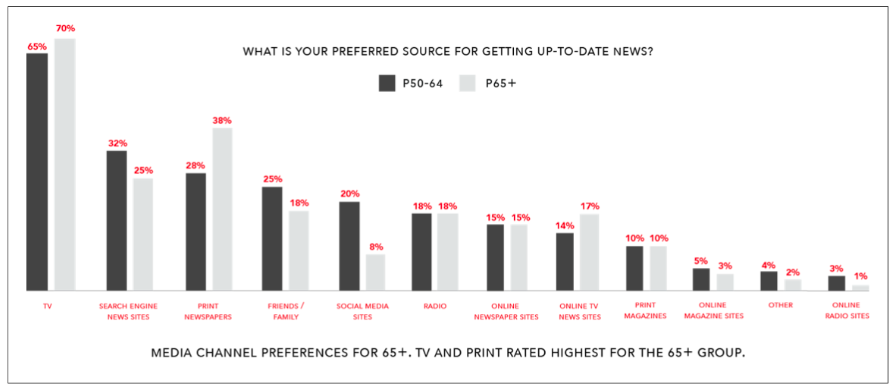
Word of Mouth
• “Word of mouth can be powerful. This can be especially true in retirement communities where residents come into contact with their neighbors on a daily basis—much more than in communities where members are working
8-10 hours a day.”
• “Seniors congregate [at] senior clubs, golf courses, malls, and Church attendance. Church attendance is highest among seniors, with 60% of the 65+ crowd reporting they attend every week.”
Television
• American retirees engage in an average of 4.2 hours of TV viewing each day, almost twice the allage average.
People age 75 and older watch more TV than any other age group.
• Adults age 65 and older watched 48 hours and 38 minutes per week, up 1.2 percent from the previous year and up by 5.1 percent over 5 years.
• 54 years old is the median age for a broadcast television user.

Word of Mouth
• “Word of mouth can be powerful. This can be especially true in retirement communities where residents come into contact with their neighbors on a daily basis—much more than in communities where members are working
8-10 hours a day.”
• “Seniors congregate [at] senior clubs, golf courses, malls, and Church attendance. Church attendance is highest among seniors, with 60% of the 65+ crowd reporting they attend every week.”
Television
• American retirees engage in an average of 4.2 hours of TV viewing each day, almost twice the allage average.
People age 75 and older watch more TV than any other age group.
• Adults age 65 and older watched 48 hours and 38 minutes per week, up 1.2 percent from the previous year and up by 5.1 percent over 5 years.
• 54 years old is the median age for a broadcast television user.
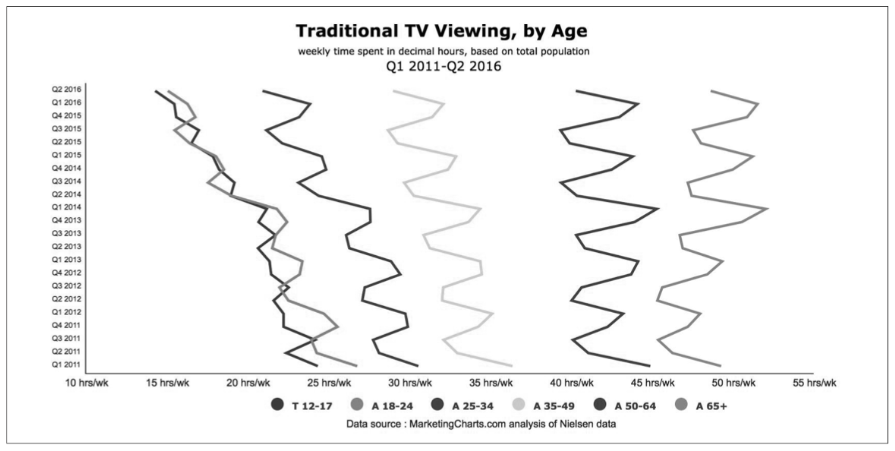
Online/Social
• “Consumers over the age of 65 continue to prefer offline communications and transactions.”
• Older adults are the fastest growing group of Internet users. According to the U.S. Census Bureau, people over the age of 65 spend more than $7 billion dollars per year online.
• “Email marketing also remains a powerful force in marketing to seniors-when used properly it still outranks all other forms of direct marketing in terms of ROI.”
• “39 million people aged 65 and older using Facebook, Twitter, and Skype.”
Of the Wired Seniors
• 94% use the Internet for e-mail
• 77% shop online
• 71% are looking for health information
RECOMMENDATIONS
Advertise on TV and in Print
Seniors over 65 spend 48.63 hours a week watching TV, much more than any other age demographic, and print is held in high regard for this age group. These two traditional forms of media have more reach than other mediums.
They are also more trusted by seniors.
Don’t Patronize
They have learned to “think and act for themselves —and they still want to be thought of that way. The least hint of patronizing the baby boomers will flatten any marketing campaign.”12 They are still competent and adaptable, and should be treated as such.
Use Social Media to Reach Seniors
Social media usage is increasing among seniors. 72 percent of people 50-plus used social media in the last 30 days.
They are the fastest growing segment of social media users; 14.8 million Facebook users are over the age of 65.
Even if large numbers of seniors are not on social media, expect a continued increase as younger boomers who use these platforms progress into old age.
Portray Their “Feel Age” Instead of Real Age
The concept of being cognitively younger is feeling psychologically younger and unaccepting of one’s true age.
Instead of meeting stereotypes, seniors want to feel they are independent and competent. They want to see other seniors as independent and competent in advertisements.
Encourage Word of Mouth
It is not only millennials who make decisions based off of their social circles; seniors also heavily rely on community.
Without a full time job, seniors are spending their time socializing with other seniors. Senior living homes allow for a community of people 65+ to share their experiences, ideas and recommendations, as do religious groups and activities like tennis, golf, bridge, etc.
Seniors over 65 spend 48.63 hours a week watching TV, much more than any other age demographic, and print is held in high regard for this age group. These two traditional forms of media have more reach than other mediums.
They are also more trusted by seniors.
Don’t Patronize
They have learned to “think and act for themselves —and they still want to be thought of that way. The least hint of patronizing the baby boomers will flatten any marketing campaign.”12 They are still competent and adaptable, and should be treated as such.
Use Social Media to Reach Seniors
Social media usage is increasing among seniors. 72 percent of people 50-plus used social media in the last 30 days.
They are the fastest growing segment of social media users; 14.8 million Facebook users are over the age of 65.
Even if large numbers of seniors are not on social media, expect a continued increase as younger boomers who use these platforms progress into old age.
Portray Their “Feel Age” Instead of Real Age
The concept of being cognitively younger is feeling psychologically younger and unaccepting of one’s true age.
Instead of meeting stereotypes, seniors want to feel they are independent and competent. They want to see other seniors as independent and competent in advertisements.
Encourage Word of Mouth
It is not only millennials who make decisions based off of their social circles; seniors also heavily rely on community.
Without a full time job, seniors are spending their time socializing with other seniors. Senior living homes allow for a community of people 65+ to share their experiences, ideas and recommendations, as do religious groups and activities like tennis, golf, bridge, etc.

Recognize Seniors are Actual Customers
Believing that seniors have made final decisions on what products they like and don’t like, brands frequently take their senior customers for granted. Although they are more loyal than younger generations, they do not follow brands blindly. Seniors at the moment possess the most buying power, and advertising should cater toward them instead of ignoring them
Notice Baby Boomers are Working Past 65
18.9 percent of people over the age of 65 are still working, and 27 percent of Americans plan on working as long as they can. This is mainly due to savings being hit by the 2008 financial crisis. 36 percent of those 65 and over who continue to work do so because they enjoy their jobs. Homes are another thing seniors aren’t leaving. Instead of moving, seniors are continuing to improve their current homes to make them more senior friendly.
Exploit the Fact They’re Living in the Suburbs
“They invented it in the sense that it occurred simultaneously with their ability to make down payments on a mortgage and their desire to leave the decaying urban landscape. They still live in the suburbs. “IS Try to target them in the suburbs. Whereas previous generations of seniors moved in with family or to retirement communities, it is important to boomers to be able to stay in their homes.
SO WHAT DOES THE FUTURE BRING?
A new generation of seniors is growing every day, meaning more changes to come.
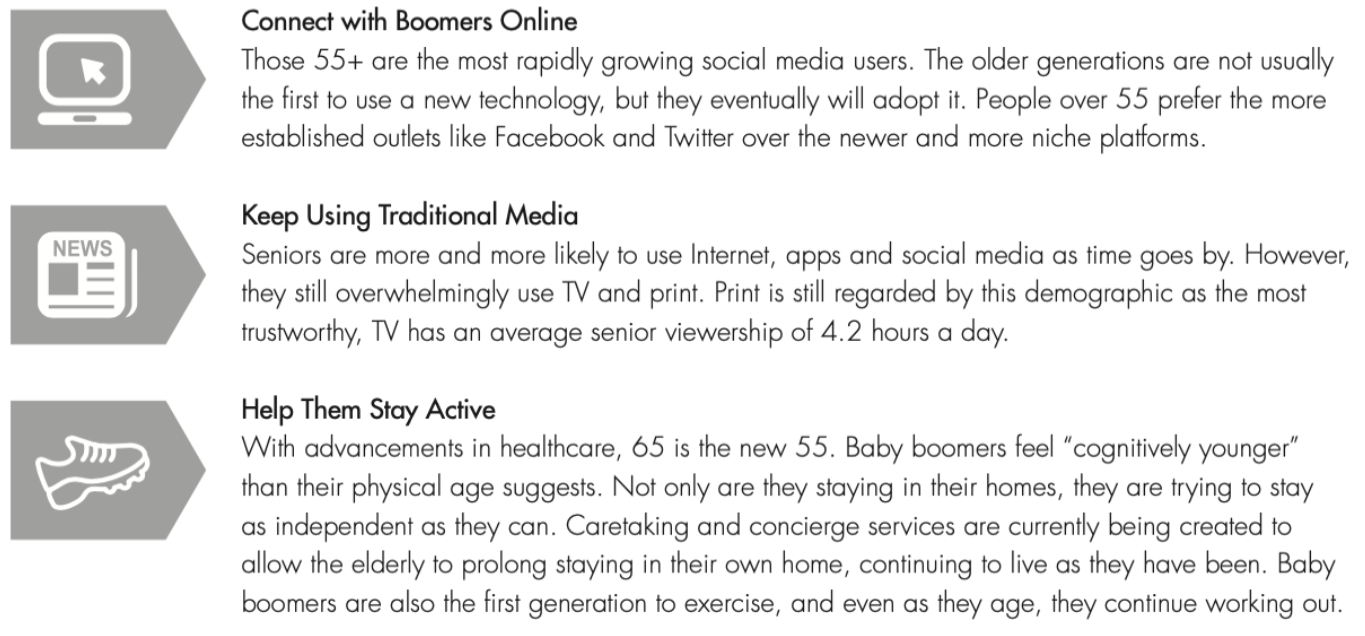

It is imperative that marketers get to know this demographic. There are common characteristics between the generational gaps like security, service and independence, but the demographic is ever changing. Understanding how this demographic will adapt to new tech, longer lives and richer communities will greatly impact your target sales and push your brand forward.
SOURCES
1 Video Advertising Bureau. (2016). 50 Shades of Green: Vast Spending Power of Adults 50+ [Report].
Retrieved from http://www.thevab.com/wp-content/uploads/2016/08/VAB-50-Shades-of-Green-Report.pdf
2 Video Advertising Bureau. (2016). 50 Shades of Green: Vast Spending Power of Adults 50+ [Report).
Retrieved from http://www.thevab.com/wp-content/uploads/2016/08/VAB-50-Shades-of-Green-Report.pdf
3 Penn State. (2016, April 12). Sorry kids, seniors want to connect and communicate on Facebook, too.
ScienceDaily. Retrieved December 9, 2016 from https://www.sciencedaily.com/releases/2016/04/
160412134737.htm
4 N.A. Premier Fitness Program: Research & Emerging Trends. (2016).
5 Risto, Barbara. (N.D.) How to market successfully to the 50+ consumer. INSPIRED Senior Living.
Retrieved from http://www.seniorlivingmag.com/articles/how-to-market-successfully-to-the-50
6 Risto, Barbara. (N.D.) How to market successtully to the 50+ consumer. INSPIRED Senior Living.
Retrieved from http://www.seniorlivingmag.com/articles/how-to-market-successfully-to-the-50
7 Risto, Barbara. (N.D.) How to market successfully to the 50+ consumer. INSPIRED Senior Living.
Retrieved from http://www.seniorlivingmag.com/articles/how-to-market-successfully-to-the-50
8 Risto, Barbara. (N.D.) How to market successfully to the 50+ consumer. INSPIRED Senior Living.
Retrieved from http://www.seniorlivingmag.com/articles/how-to-market-successfully-to-the-50
9 Risto, Barbara. (N.D.) How to market successfully to the 50+ consumer. INSPIRED Senior Living.
Retrieved from http://www.seniorlivingmag.com/articles/how-to-market-successfully-to-the-50
10 Reger, R. (2014). 6 Keys to Engage Seniors Online. Retrieved December 09, 2016, from http://www.targetmarketingmag.com/article/6-keys-engage-seniors-online/all/
11 Beesley, C. (n.d.). Marketing to Seniors and Baby Boomers: Have you. Retrieved December 09, 2016, from https://www.allbusiness.com/marketing-to-seniors-and-baby-boomers-haveyou-13940100-1.html
12 Olenski, S. (2015, June 05). 7 Reasons Why Marketing To Baby Boomers Is Unique. Retrieved December 09, 2016, from http://www.forbes.com/sites/steveolenski/2015/06/05/7-reasons-why-marketing-to-baby-boomers-is-unique/
13 Olenski, S. [2015, June 05). 7 Reasons Why Marketing To Baby Boomers Is Unique. Retrieved December 09, 2016, from http://www.forbes.com/sites/steveolenski/2015/06/05/7-reasons-why-marketing-to-baby-boomers-is-unique/
Retrieved from http://www.thevab.com/wp-content/uploads/2016/08/VAB-50-Shades-of-Green-Report.pdf
2 Video Advertising Bureau. (2016). 50 Shades of Green: Vast Spending Power of Adults 50+ [Report).
Retrieved from http://www.thevab.com/wp-content/uploads/2016/08/VAB-50-Shades-of-Green-Report.pdf
3 Penn State. (2016, April 12). Sorry kids, seniors want to connect and communicate on Facebook, too.
ScienceDaily. Retrieved December 9, 2016 from https://www.sciencedaily.com/releases/2016/04/
160412134737.htm
4 N.A. Premier Fitness Program: Research & Emerging Trends. (2016).
5 Risto, Barbara. (N.D.) How to market successfully to the 50+ consumer. INSPIRED Senior Living.
Retrieved from http://www.seniorlivingmag.com/articles/how-to-market-successfully-to-the-50
6 Risto, Barbara. (N.D.) How to market successtully to the 50+ consumer. INSPIRED Senior Living.
Retrieved from http://www.seniorlivingmag.com/articles/how-to-market-successfully-to-the-50
7 Risto, Barbara. (N.D.) How to market successfully to the 50+ consumer. INSPIRED Senior Living.
Retrieved from http://www.seniorlivingmag.com/articles/how-to-market-successfully-to-the-50
8 Risto, Barbara. (N.D.) How to market successfully to the 50+ consumer. INSPIRED Senior Living.
Retrieved from http://www.seniorlivingmag.com/articles/how-to-market-successfully-to-the-50
9 Risto, Barbara. (N.D.) How to market successfully to the 50+ consumer. INSPIRED Senior Living.
Retrieved from http://www.seniorlivingmag.com/articles/how-to-market-successfully-to-the-50
10 Reger, R. (2014). 6 Keys to Engage Seniors Online. Retrieved December 09, 2016, from http://www.targetmarketingmag.com/article/6-keys-engage-seniors-online/all/
11 Beesley, C. (n.d.). Marketing to Seniors and Baby Boomers: Have you. Retrieved December 09, 2016, from https://www.allbusiness.com/marketing-to-seniors-and-baby-boomers-haveyou-13940100-1.html
12 Olenski, S. (2015, June 05). 7 Reasons Why Marketing To Baby Boomers Is Unique. Retrieved December 09, 2016, from http://www.forbes.com/sites/steveolenski/2015/06/05/7-reasons-why-marketing-to-baby-boomers-is-unique/
13 Olenski, S. [2015, June 05). 7 Reasons Why Marketing To Baby Boomers Is Unique. Retrieved December 09, 2016, from http://www.forbes.com/sites/steveolenski/2015/06/05/7-reasons-why-marketing-to-baby-boomers-is-unique/

